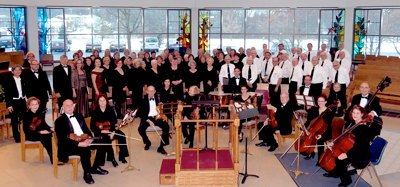by Robert Rollin
With all the bad news and sadness we encounter today nationally, internationally, and in everyday life, the Warren Civic Chorus’s performance of Handel’s Messiah was a magnificent gift to the city of Warren. The oratorio is a vivid, positivistic, religious affirmation of belief in future salvation, and a powerful, vocal, choral and instrumental depiction of its biblical subject matter.
The musicians, directed by Hae-Jong Lee of the Dana School of Music, showed remarkable fortitude, presenting two full Messiah performances at 4:00 and 7:00 p.m. this past Sunday in the attractive and the acoustically lovely sanctuary of Warren’s Blessed Sacrament Catholic Church. The three-part work, with each division shorter than the one before, increases in intensity to the climactic “Hallelujah Chorus” at the second part’s close, features a kind of dénouement in the third, and ends with the lively “Amen Chorus.”
The Warren Civic Chorus’s ranks were swelled with volunteers from Youngstown’s Stambaugh Chorus, also directed by Lee, and numbered over sixty singers. The accompanying orchestra consisted of a small complement of eleven strings, two trumpets, and timpani. Handel had cued oboes and bassoon into the string parts, so their absence created no loss of moving parts, but rather, a loss of the interesting double-reed timbre.
Notwithstanding, it was an excellent performance. The small orchestral forces allowed soloists and chorus to project clearly in the attractive church sanctuary. Jeff Trimble and Kathy Miller were fine continuo players. Such small instrumental forces made it essential that each player cover his or her part effectively, and the performers did this expressively and with poise.
After a lovely performance of the overture, tenor Leonard Suzelis excelled in the renowned aria, “Every Valley,” with especially lovely melismas on the word “exalted.” This is among Handel’s most beautiful tenor arias. The opening chorus, “And the Glory of the Lord,” was appropriately uplifting.
Alto Karen Emmet shined in her first recitative and da capo aria, “Thus Saith the Lord and But Who May Abide the Day of His Coming.” She projected a beautiful vocal quality, further enhanced in the recitative by sixteenth notes in the strings, painting the words “I’ll shake the Heavens.” Similarly in the aria’s prestissimo section, the fast strings accompanied her melismas on “He is like a refiner’s fire” with precision. The chorus “And He Shall Purify” was gorgeous and full of melismas on “purify.” The wonderful bass air, “The People Who Walked in Darkness,” was superb. Max Pivik’s timbre was captivating, and tone painting abounded.
Trumpets and timpani joined in for the extended chorus, “For Unto Us A Son is Born.” Trumpeters Susan Sexton and John Venesky gleamed with virtuosity, and timpanist Tyler Hasosky energetically added the requisite power. The closing portion of Part 1 emphasized the solo soprano. Misook Yun did very well, but her vibrato sometimes made it difficult to understand the words. Her final air was hampered a bit by ensemble issues in the cellos.
The powerful beginning of Part 2 concentrated on alto solo and chorus, and was excellent. Emmet’s “He Was Despised” was stunningly beautiful and truly worthy of this great piece. Wondrous sequences and a fine string da capo enlivened the performance. The surrounding choruses, particularly “And With His Stripes We Are Healed” and “All We Like Sheep” featured stimulating harmony and fugatos.
The Bass air “Why Do Nations So Furiously Rage?” scintillated with Pivik’s singing and lovely violin section passagework. This led inexorably to the majestic “Halelujah Chorus” and its great fugato sections. The performance was excellent, and only got a bit muddy in the unsupported soft passages.
Some textual intelligibility marred Yun’s otherwise attractive soprano aria at the beginning of Part 3. Pivik again sparkled in his recitative and aria, “Behold, I Tell You A Mystery” and “The Trumpet Shall Sound.” The final two choruses were glorious, as were the accompanying trumpets, timpani, and strings.
Published on ClevelandClassical.com December 9, 2014.
Click here for a printable copy of this article.




